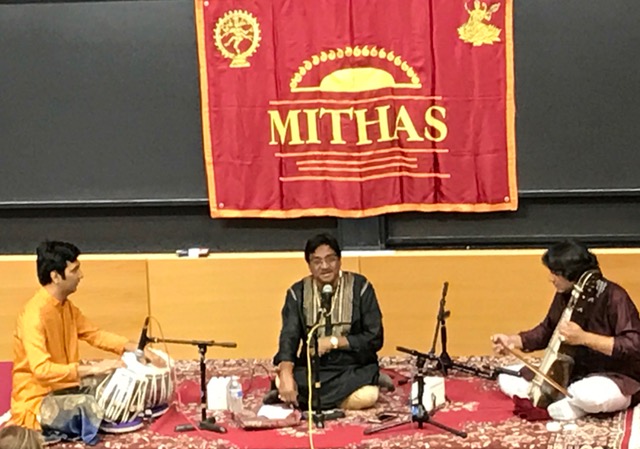Contribute
| Delightful Hindustani Classical Fare By Ustad Mashkoor Ali Khan |
Shuchita Rao
10/20/2016
Ustad Mashkoor Ali Khan presented a Hindustani classical
vocal recital at MIT’s Wong Auditorium on Saturday, October 15 at 7pm as part
of the MITHAS (MIT Heritage of Southasia) 2016 Fall season Indian classical
music program series. Khan Saheb is the son of the renowned Sarangi player, the
late Padmashri Ustad Shakoor Khan and a representative of the Kirana Gharana
established by stalwarts such as the late Ustad Abdul Karim Khan and the late
Ustad Abdul Waheed Khan. A resident Guru at the prestigious I.T.C Sangeet
Research Academy in Kolkatta, India since 1980s, Khan Saheb is credited with
having one of the richest collections of melodies in the khayal genre of
Hindustani classical music. The talented Shri Meghashyam Keshav (disciple of
Pandit Vishwanth Nakod, Pandit Udayraj Karpur, Pandit Ravindra Yavagal and
Pandit Anindo Chatterjee) provided sensitive accompaniment on the tabla while
the accomplished Kamal Sabri, son of the legendary Sarangi player, Ustad Sabri
Khan provided support on the rich and resonant instrument, the sarangi. 45
people attended the concert with some attendees driving down from Albany and
New York city to listen to the vocal music concert. The first raga to be presented was the night melody Shuddh
Kalyan that has five notes of popular raga Bhoopali in its ascent and seven
notes of raga Kalyan in its descent. “Eri Maayi Piyaâ€, a slow tempo composition
set to the Jhoomra taal of 14 beats was full of graces and glide ornaments in
the descent which is a characteristic feature of Shuddh Kalyan. Much to the
delight of the audience, gamak taans (fast melodic passages with weighty
oscillations) featured in the “antara†portion of the melody in the upper
octave showed the artist’s skill in rapidly alternating musical phrases between
lower, middle and upper vocal registers. In the faster paced traditional
composition that followed, “Mandar baajo, baajo reâ€, the artist sang a variety
of attractive bol-taans and sargam-taans with accented musical notes to create
a modulated rendition. The tabla and sarangi artists were given opportunities
to showcase their strengths in solos towards the end of the hour long
presentation. Concert attendee MIT’s Associate Dean & Senior Strategic
Advisor for Digital Learning, Professor MS Vijaya Kumar said “The Shuddh
Kalyan presentation was refreshingly good and full of sweetness (mithaas)â€. The second raga to be presented was Raga Bihag. “Dekho Sakhi Kanhaiyya roke thaado haathâ€
set to medium tempo 16 beat cycle teentaal began on the first beat of the
cycle. The catch phrase of the raga PmGMG showing both shades of the madhyam
note was repeated several times to establish the raga which sometimes tended to
show a romantic mood (shringara rasa)
and was at other times laden with the sadness of separation (viraha rasa). The second composition “Tumre roop hum jaane pehchaane†set to
12 beat cycle ektaal in a fast tempo had taans spanning all three octaves. The
artist endowed with a strong sense of rhythm unfailingly arrived at the opening
key phrase of the khayal (mukhra) at
the right spot in the rhythmic cycle. It was wonderful to see the accompanying
artists appreciate the vocalist who in turn encouraged them to express their
individual unique touches to the team’s presentation. The next two compositions were short and sweet and in ragas
Adana and Shahana respectively. “Kalinath
Chetana Karo†in ten beat rhythmic cycle jhaptaal had plenty of gamak
ornamentation and the zig-zag movement characteristic phrase “PaniPaGaMaReSaâ€
repeating often in the presentation. “Jaane
man Jaane man Jaananeman†in raga Shahana was a lovely composition of the
legendary Hazrat Amir Khusro that had Persian as well as rhythmic percussion
syllables in it. There were engaging “sawaal-jawaab†(question and answer) exchanges between the vocalist and the sarangi
accompanist in this rendition. The final presentation was a melodious thumri “Koyaliya kook sunaaye†set to addha
teentaal of 16 beats in Raga Khamaj presented in the Punjab-Ang style of thumri
presentation. It was replete with murki ornamentation and the skillful use of
adjacent variant notes of rishabh, gandhar and madhyam. The
climactic “laggi†section of the thumri presentation brought the recital
to an exciting finish. The artist Ustad Mashkoor Ali Khan thanked the organizers,
the accompanists and the audience by saying “Music is that which happens when
an artist sings with all of his/her heart and a listener listens with all of
his/her heart†(Koyi dil se gaaye aur
koyi dil se sunay – gaana wahi hai! ) There could have been no better
poetic way to sum up the concert that left listeners wanting to hear more music!
You may also access this article through our web-site http://www.lokvani.com/
